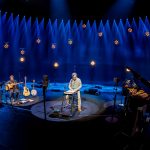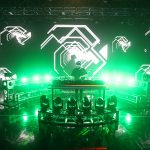
Houston Livestock and Rodeo 2018 Gets a New Look
The Houston Livestock Show and Rodeo (HLSR), also called RodeoHouston, is the largest livestock exhibition and rodeo in the world. The rodeo runs for 20 days, attracting over two million people each year, and has committed over $450 million to the youth of Texas since 1932. It is considered the city’s signature event, comparable to Mardi Gras in New Orleans or New York City’s New Years Eve in Times Square.
For over 30 years on each of those 20 nights, some of the world’s biggest recording artists have performed in the round on the iconic rotating stage. Starting in 2015, however, the rodeo board of directors has been looking for a solution to replace the old stage. It had served them well, but maintaining it just wasn’t cost effective. HLSR also wanted to reinvent their brand and bring their production to a whole new level.
The old stage was built for the Astrodome. Inside NRG stadium, where the rodeo has been staged since 2003, it looked like a postage stamp. Remember, this is Texas. The board at HLSR emphasized during the development process that this is not a “hay wagon getting dragged out by a tractor.”
The board of directors wanted to continue to attract big name talent and make sure the artists felt comfortable on the new stage — and that acts did not feel they were stepping on their own brand by not bringing in their own production.

A Star is Born
The idea for the star shaped stage came together after a meeting between The Houston Rodeo board of directors, Rob McKinley, president of LD Systems and Tait Towers project manager Aaron Siebert about what shape it should be and how to get the performers closer to the audience.
Sitting in the Houston airport afterwards, surrounded by illustrations and graphics of the iconic Lone Star of Texas, one of the traveling party said, “You know, this would be the perfect shape.” And “The Star” was born.
The star shaped revolving stage area is 48 feet in diameter. The stage is elevated seven feet off of the arena surface, and each of the five star points can be individually lowered or raised to create unique performance positions. Each stage star point is 36 feet long making the stage 126 feet wide from tip to tip. The stage also features a 28 foot tall by 56 foot wide, LED backdrop video screen with an automated positioning system — all of which is controlled by the Tait proprietary automation system, Navigator.

To overcome the problems presented by the dirt surface, the Tait team looked extensively into research and development in design and engineering for the driving suspension systems. The NRG stadium floor is covered in 12 to 16 inches of a combination of clay and loose pack, for the duration of the rodeo, which is turned over several times a day.
“One of the biggest challenges,” says Siebert, “was how to make this huge stage drive out to position on soft dirt while simultaneously dealing with the fact it is never on a level surface. A lot of debate went into track versus tires.”
Ten hydraulic motors run 20 forty-eight inch solid rubber tires to drive the stage. These wheels are set up in pairs, and every pair has an airbag suspension as well as a hydraulic suspension system that can lock off the air and level the stage when it is in performance mode. The airbags solve the problem of driving on uneven terrain, and the hydraulics provides a solid, stable platform when performers are on the rotating stage. The wheels attach to gimbals (a pivoted support that allows the rotation of an object about a single axis), so they can roll in any direction to deal with the uneven terrain.
Each of the five star points has four multi axes and can do what is known as a “cobra move” — the base of the star point tilts up, while the remaining 12 feet tip in a counter rake move so it remains level to the ground, and can go as high as 30 feet, parallel to the ground.
The 28-foot-high automated back wall has seven columns that are 24 feet tall, each with another four foot “horn” on top. An Art-Net link from the Navigator system gives control to the grandMA board operator, triggering the 14 axes of motion in the backdrop. Everything else in the system is controlled by Navigator and run by an automation team that deals with all the driving of the stage, all the star point moves, and performer safety.
Navigator controls the positioning system as the stage drives out via two laser scanners mounted in the” garage.” These “ping” on the stage reflectors to do an absolute feedback loop of stage position.
To give an idea of the accuracy of the system, the stage, which weighs over 360,000 pounds, travels 220 feet from performance position to the “garage,” staying within one-inch accuracy. That’s important, because, when parked, there’s only eight inches of clearance on each side between the stage and the concrete walls.
Along with all of the other upgrades, the Rodeo board of directors wanted to eliminate the 20 to 30 minutes it used to take to wire the old stage once it was rolled into place. They were after a more dynamic entrance as well. Toward those ends, cable management was revamped in a way so that the four sets of 4/0, all the fiber, data and analog signal, network and video signal stays plugged in as it feeds out from the garage. Once in position, a custom cable system to accommodate the turntable allows four rotations forward before having to reverse four rotations.
In addition to the stage, Tait has NavCam, a 3D four point flying camera rig that is similar to what the NFL uses.
Forty-three NavHoists, Tait’s automated chain hoist, provide the reveal for the lighting system lowering from inside the circular video wall. With the more sophisticated and larger stage came increased production with additional lighting and video needs.
A separate Navigator system controls the NavCams, but it communicates with the Navigator system controlling all automation to provide position feedback of the stage to the NavCams. “This way,” says Siebert, “we get real time feedback so the cameras can follow the star point moves and avoid running into the stage space.”

A Dynamic Backdrop
The new stage continues the original RodeoHouston stage theme — the Texas-sized lighting and video backdrop structure designed by LD Systems. The new backdrop is 28 feet high with 434 lighting fixtures and automated movement of Hybrid LED video modules. This combines a dynamic backdrop with a variety of video screen shape configurations with a level of transparency that lets the audience see performers from behind as the stage revolves.
Nathan Brittain of LD Systems, lead designer and programmer for the event, notes how Rodeo Houston took a big step forward this year. “We knew the stage was massive, and that it would take a very large number of fixtures to really make it stand out. Our goal was to really bring this amazing structure to life,” he says. “The entire team, Tait, HLSR and our team and crew at LD Systems did a great job of remaining positive through the whole process despite all the challenges and long hours. I think the results are evident, and it paid off.”
A key consideration during the upgrade process, Brittain adds, was the overall weight of the rig. “I started with the large format fixtures I knew I had to have, because we’re in a stadium. This got me the basic infrastructure that I needed to do the show. After that, I filled in the rig with smaller, lighter-weight fixtures to complement everything and create a huge system. That is why there are a lot of Robe Spikies, Chauvet Strike 1 Moles and Elation Paladin LED’s.”
The main lighting system is divided into two separate control areas. The stage and overhead are on one grandMA2, and the audience package is on a second board. Three Green Hippo Boreal Plus media severs drive all the video surfaces, with a third grandMA2 as its control interface.
A rotating stage presents obvious problems for lighting focuses. Brittain met those challenges with the “Horn.” Fourteen High End Sola Spots are mounted on top of the backdrop, which is built on the center dais, so it rotates with the stage on the “Horn” for back key lights. Above the stage, a 360-degree wash evenly lights the whole rotating stage. Robert Juliat Dalis 862’s (strip lights) on the very edge of the revolving turntable provide up light for performers wearing cowboy hats so the cameras can show their faces.
“We have a lot of GLP fixtures,” says Brittain. “We’ve used X4’s in the past, but nowhere near as many as we now have. They have a nice beam that reads well on camera. It is just a great fixture that we love.” Brittain knew he needed and wanted a strong strobe behind the stage. “About 10 months ago, GLP introduced their JDC1 strobe, and I knew instantly that was the fixture for this job.” Seventy of them were incorporated into the design.
In addition to the strobes, the LD needed a glow to give depth to the bottom of the star points. For that, Brittain used Color Kinetic Color Blast TRX fixtures, on each point. “It’s a simple touch that creates so much depth,” he says. “That was one of the initial design elements we discussed. The wash fixtures were the same as we have used in the past; the VL3500. It does the job so well.
“A problem we have had in the past with this room is getting a profile unit to read on stage,” continues Brittain. “Between the big lighting rig and all the light pollution from the video walls everywhere, getting a profile to cut through with any gobo pattern has always been tough. The Claypaky Unico has that hotspot and a huge lens that just pushes through. It has worked very well, and looks great in that room.”

Massive Video Displays
The huge amount of video surface features a variety of content via Green Hippo Boreal Plus media servers. played back flawlessly. When it came time to upload and manage files from incoming artists, “the Hippo’s made our workload simple,” says Brittain. LD Systems partnered with Screenworks for the overhead main I-Mag screen and the header ring above it.
At 56 feet wide and 28 feet tall the Arc that creates the back wall is a huge component to both the stage and lighting design. It also works as a very practical set element.
“We wanted to improve the resolution as much as we could, but not close it down so it was a solid wall,” says Rob McKinley, GM of LD Systems. “We chose the ROE Hybrid 18mm product that has LED blinder spots built into the panel. That is a design choice we carried over from the old stage so the audience is not completely disconnected from the band. It also allows lighting fixtures to blow through from behind it, adding yet another layer.”
LD Systems collaborated with Tait in the building and design of the back wall to make it as wide as possible. “It is not a perfect circle,” says McKinley. “It is more of an arc, which gives the artist that is performing on a 48-foot stage a real sense of a back wall behind their backline.”

Since content and media creation has become more prevalent and important in an artist’s presentation, having a back wall that is configurable, video wise, helps play into that. The bands’ designers can do pre-viz and pre-design the back wall looks with their own content. This way, the artists can present more of their shows rather than feeling like they have to come in and compromise. “It was real important in working with Tait that we engineer a back wall with automation to provide a lot of different looks for the artist’s presentation,” McKinley says.
Above the stage, and masking the huge lighting system, is a circle of video screens. This serves a dual purpose, providing images for the rodeo and the concerts. Eight large I-Mag screens, measuring 30 by 24 feet, are interspersed with eight-by-24-foot filler screens. The large I-Mag screens portray the live shots while the fillers provide statistics and other information. Above the faceted screens is a perfect circular header measuring 116 feet in diameter, while the bottom one completes the look at 104 feet in diameter.
“We received a ton of support from the Rodeo, all the way from the chairman of the board, CEO, and our liaison the head of operations, Mike Demarco, down to the crew and staff who taught us a lot about dirt; the different consistencies, how to setup the dirt to work properly for rodeos but also be able to run for the stage,” says Siebert. “I never thought I would know so much about dirt,” he laughs.
“Something like this doesn’t happen without the hard work and dedication of hundreds of people,” Siebert adds. “I just get to be the guy who happened to get the phone call. Without the whole support team, this never would have been possible.”


